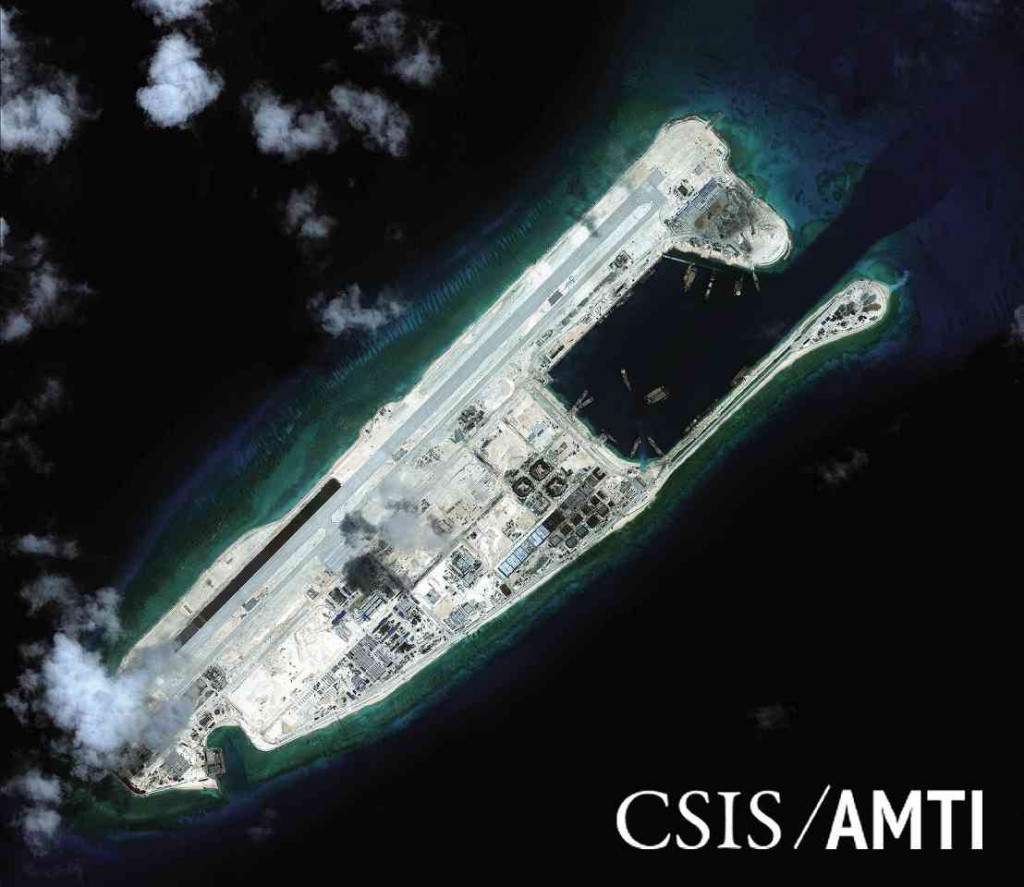China landing on PH reef hit

DISPUTED REEF Photo provided by the Center for Strategic and International Studies show Kagitingan (Fiery Cross) Reef (above) with a 3,125-meter-long airstrip built by China and reclamation work going on on the reef in the Spratly archipelago also claimed by the Philippines and Vietnam. REUTERS/CSIS/AFP/PAO
THE PHILIPPINES will protest China’s landing a plane on an airstrip it has built on an artificial island in the hotly contested Spratly archipelago in the South China Sea, Malacañang and the Department of Foreign Affairs (DFA) said on Sunday.
The Chinese foreign ministry released a statement late Saturday saying Beijing had completed construction of an airfield on Philippine-claimed (Fiery Cross) Reef, and recently used a civilian plane to conduct a flight testing whether the facilities were up to civil-aviation standards.
The statement immediately drew protest from Vietnam, which also claims Kagitingan, calling the reef Da Chu Thap.
Le Hai Binh, spokesperson for the Vietnamese foreign ministry, said the airstrip had been “built illegally” on the reef in territory in the Spratlys that was “part of Vietnam.”
Binh said the Chinese test flight violated Vietnam’s sovereignty, breached mutual understanding and hurt bilateral relations.
Article continues after this advertisement“Vietnam resolutely protests Chinese above-said action and demand that China immediately stop, not repeat similar actions,” Binh said in a statement.
Article continues after this advertisementIn Manila Sunday, Presidential Communications Secretary Herminio Coloma Jr. said in a text message that the DFA would protest the Chinese action.
In a separate text message, Charles Jose, spokesperson for the DFA, said the department would “also be lodging a protest” with China over the test flight to Kagitingan.
Jose said Kagitingan was part of the Kalayaan Island Group that belonged to the Philippines.
China, which claims almost the entire 3.5-million-square-kilometer South China Sea, rejected Vietnam’s protest.
In a response Saturday, Chinese foreign ministry spokesperson Hua Chunying said the test flight to Kagitingan, which the Chinese call Yongshu Island, was a matter “completely within China’s sovereignty.”
“The Chinese side will not accept the unfounded accusations from the Vietnamese side,” Hua said in a statement.
She added that China hoped Vietnam could work to achieve “sustainable, healthy and stable” development of bilateral ties.
Artificial islands
China has become more assertive in pressing its claims to the South China Sea, building artificial islands on reefs in the Spratlys, an archipelago rich in natural resources that is the focal point of rival claims by neighboring countries.
Besides the Philippines and Vietnam, Brunei, Malaysia and Taiwan also claim parts or all of the South China Sea, which is crisscrossed by sea-lanes through which $5 trillion in global trade passes every year and where islets, reefs and atolls are believed to be sitting atop vast energy reserves.
China has piled sand atop seven reefs in the Spratlys, on at least two of which it has built airstrips, radar installations and docking facilities.
Besides Kagitingan, China has built artificial islands on Calderon (Cuarteron), Burgos (Gaven), Mabini (Johnson South), Panganiban (Mischief), Zamora (Subi) and McKennan (Hughes) reefs, all claimed by the Philippines and within the country’s 370-kilometer exclusive economic zone recognized under the United Nations Convention on the Law of the Sea.
Opaque policy
As with most of its policy in the South China Sea, Beijing has remained opaque about its plans for the airstrips.
China insists its island-building works are justified and do not constitute a threat to stability and freedom of navigation. But the United States and its regional allies have expressed concern that China’s robust assertion of its claims has aggravated tensions.
Although the Philippines and Vietnam already have airstrips in the Spratlys, these are just long enough to accommodate slow-moving cargo and surveillance planes.
China’s airfield on Kagitingan has a 3,125-meter-long runway, long enough to receive bombers capable of launching cruise missiles.
Regional tensions
The United States said it was concerned that the test flight had exacerbated tensions in the region.
Washington has criticized China’s construction of artificial islands in the South China Sea and worries that Beijing plans to use them for military purposes, even though China says it has no hostile intent.
Pooja Jhunjhunwala, a spokesperson for the US state department, said there was “a pressing need for claimants to publicly commit to a reciprocal halt to further land reclamation, construction of new facilities and militarization of disputed features.”
“We encourage all claimants to actively reduce tensions by refraining from unilateral actions that undermine regional stability, and taking steps to create space for meaningful diplomatic solutions to emerge,” she said.
Although not taking sides in the territorial disputes, the United States has challenged China’s claim of sovereignty over nearly the whole South China.
In October, the United States sent a guided missile destroyer sailing near one of the artificial islands built by China in the Spratlys. In
December, it also sent two B-52 strategic bombers flying near the artificial islands.
US ally Australia also sent a surveillance plane flying near the artificial islands in early December, showing it did not recognize China’s expansive claims in the South China Sea.
PH arbitration case
Without military muscle to defend its claims in the South China Sea, the Philippines has taken its territorial dispute with China to the United Nations Permanent Court of Arbitration in The Hague for resolution.
China has ignored the proceedings, saying it will not accept any decision by the tribunal.
The court, however, has proceeded to hear the Philippine case, and is expected to hand down a decision by June. With reports from the wires
RELATED VIDEOS